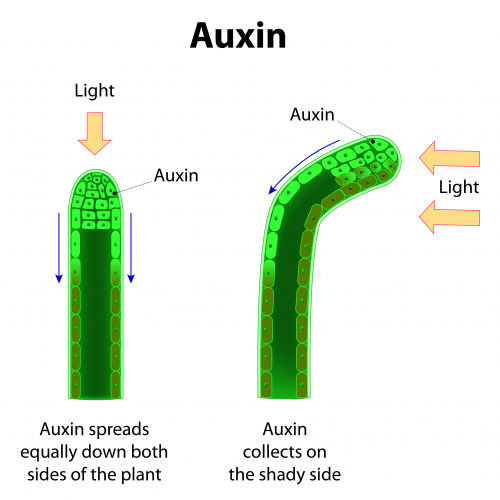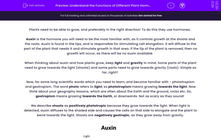Plants need to be able to grow, and preferably in the right direction! To do this they use hormones.
Auxin is the hormone you will need to be the most familiar with, as it controls growth at the shoots and the roots. Auxin is found in the tips, and is responsible for stimulating cell elongation. It will diffuse to the part of the plant that needs it and stimulate growth in that area. If the tip of the plant is removed, then no growth will occur, as there will be no auxin available.
When thinking about auxin and how plants grow, keep light and gravity in mind. Some parts of the plant need to grow towards the light (shoots) and some parts need to grow towards gravity (roots). Simple so far, right?
Now, for some long scientific words which you need to learn, and become familiar with - phototropism and geotropism. The word photo refers to light, so phototropism means growing towards the light. Now think about your geography lessons, which are often about the Earth and the ground, rocks etc. So, geotropism means growing towards the Earth, or downwards. Not as scary as they sound!
We describe shoots as positively phototropic because they grow towards the light. When light is detected, auxin diffuses to the shaded side and causes the cells on that side to elongate and the plant to bend towards the light. Shoots are negatively geotropic, as they grow away from gravity.

Roots are positively geotropic, as they grow towards gravity and negatively phototropic, as they grow away from the light. If a root is growing sideways, it will have more auxin on the lower side, but, in a root, the auxin inhibits growth, so the cells on the upper side would elongate, forcing the root to bend downwards.
Plant hormones are very effective when left to work naturally. However, we are also able to use them in an artificial way to do all kinds of useful things:
Weedkillers: Auxin can be used as a selective weedkiller. It can target only broad leaved plants (which most weeds tend to be), disrupting their growth pattern and killing them off.
Rooting powder: Gardeners often take a cutting from a plant and grow new plants from it. But, if you just put the branch you have cut straight into the soil, it will not grow. If, however, you add rooting powder, which contains selected hormones, and then add it to the soil, it will produce roots very quickly. This will allow it to anchor into the ground and start growing. The plant that grows will be a clone of the original plant.
Tissue culture: This is another method for growing plants that are genetically identical to the original plant. Small groups of cells are taken from a plant and put into a special liquid. Plant hormones can be added to encourage the development of roots, stems and leaves.
Ripening of fruit: Fruit often has to travel a long distance before it makes it to the consumer. Farmers can use hormones to control the ripening of fruit, either when it is still on the plant or when it has been loaded up and is on its way to be sold. Fruit can be picked when it is still unripe, but when ethene (the ripening hormone) is added, the fruit will ripen and be just right when it reaches the consumer. Lots of different fruits naturally release ethene when they go off, which is why you will notice that one rotten piece of fruit can quickly turn the whole fruit bowl rotten!
Dormancy: Sometimes seeds take a while to germinate. This process can be speeded up by applying another hormone called gibberellin. This means that seeds can be made to germinate at all times of the year, not just when they would naturally do it. This same hormone can also promote flowering and increase fruit size.
There's a lot to get your head around here, so it might be a good idea to read this Introduction once more before having a go at the questions.








